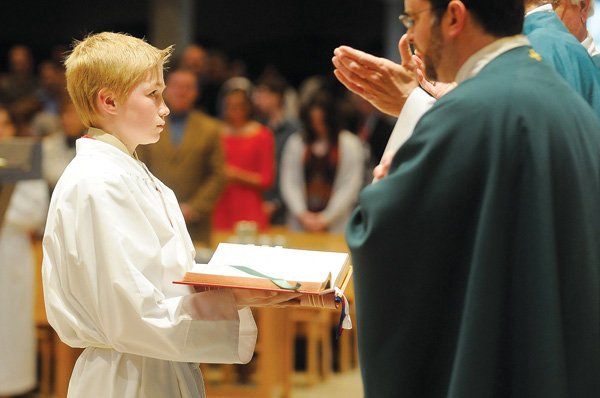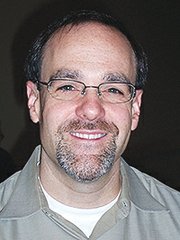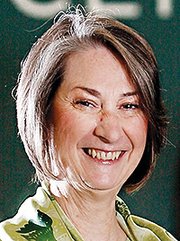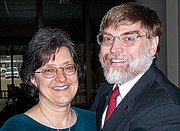ROGERS — The priest says, “The Lord be with you.” The people reply, “And with your spirit.”
After 12 weeks of repetition, the response is coming more easily to parishioners accustomed to saying “And also with you.”
Yet sometimes they stumble.
“It’s hard,” said Eddie Hunter, 9, after Mass at St. Vincent de Paul Catholic Church on Feb. 5. “I messed up today. I almost made it through the whole Mass (there are five of the exchanges during the service) but said ‘And also with you’ at the end.”
Church members of all ages report similar challenges as they adapt to changes in the Roman Missal. The changes were enacted on Nov. 27, the first Sunday of Advent, which is the start of the liturgical year.
The changes are not to the Mass, but in the wording of the prayers, chants and responses, said Debi Snyder, director of adult formation at St. Vincent de Paul. When the Latin Mass was translated into English in the early 1970s, words were chosen to convey the meaning, rather than the exact wording of the original, she said.
Now, the missal has been rewritten to more accurately reflect the Latin text put in place by Pope Paul VI in 1969, Snyder said. The process was started by Pope John Paul II a decade ago and mandated by Pope Benedict XVI last year.
“The goal is to get the English translation more in line with the rest of the world,” Snyder said. Most other language translations cleave more closely to the original, she said. “By doing that, it creates more unity.”
Not all Catholics embrace the missal changes. Some see it as a dismantling of gains won by the Second Vatican Council in the 1960s.
The bishops decided to give lay people a greater role in the Mass and translate the liturgy from Latin to the vernacular.
The new translation reinforces the hierarchical structure of the church, critics say. “And with your spirit” is directed specifically to one who is ordained, for example, rather than themore inclusive “And also with you.”
Some critics take issue with the way the process of the translation was closed to the larger church.
Anthony Ruff is a Benedictine monk who served for a time with the International Commission on English in the Liturgy, the group that translated the Mass.
Last February, Ruff published an open letter to U.S. bishops calling the new translation “part of a larger pattern of top-down impositions by a central authority that does not consider itself accountable to the larger church.”
He described the process as “secretive” and “unsatisfactory” and charged that the Holy See “allowed a small group to hijack the translation at the fi nal stage.”
Parishioners at St. Vincent de Paul have accepted the changes with good grace, Snyder said. It’s almost become a game to see how closely they adhere to the once-unfamiliar words.
“The use of technology has been a tremendous help,” she said. A PowerPoint program projects the new words onto sanctuary walls to prompt people’s responses.
Laminated cards in the pews highlight the revised text.
The church started preparing parishioners last spring, Snyder said.
The proactive approach has paid off. The challenge now is reaching churchgoers who attend Mass rarely. Snyder is thinking ahead to Easter Sunday and how to involve newcomers with the revised text, she said.
Below, several area Catholics share their reactions.
◊◊◊
Jane Quinn, 73, said the new missal represents a return to some of the traditions she remembers from pre-Vatican II. Then, the Mass was in Latin, with the priest facing away from the people and toward the altar.
She welcomed the more inclusive changes of Vatican II, Quinn said. Yetsome of the reverence seemed to be lost. She noted the reinstated full confession, where parishioners touch their breastbones and say, “Through my fault, through my fault, through my most grievous fault.”
“That’s very meaningful. It brings it back (to where the error started): ‘This is my fault.’”
Quinn is less enthusiastic about “consubstantial with the Father,” which replaced “one being with the Father” in the Nicene Creed.
“I don’t know why they chose that.” Younger people in particular stumble over the phrase, she said.
“It’s a give and take,” Quinn said.
“Some of the changes I really enjoy.
Some, the way we were saying it before was more comfortable.”
The changes, whether comforting or cumbersome, don’t affect the way she feels about the Mass, Quinn said.
Receiving the Eucharist is a deep opportunity to connect with “the body and blood, soul and divinity of Jesus Christ.”
◊◊◊
Ken Hunter, who attended Mass at St. Vincent de Paul with his family Feb. 5, called the missal changes “a big adjustment.” They push parishioners past their comfort levels,which can be a good thing, he said.
“You don’t realize how automatic the prayers have become until there’s a word change,” he said. “It makes it more meaningful.” Hunter hasn’t considered the words of the Mass so carefully since he converted to Catholicism 16 years ago, he said.
He and his wife, Antonietta, like the fact that the new translation is more closely aligned with translations in other languages, he said.
“We’re saying the exact same words, every single Eucharist Mass, around the world.”
◊◊◊
Kathryn Birkhead, who formerly attended St. Raphael Catholic Church in Springdale, decided to leave the Roman Catholic Church when missal changes were announced last February.
“Of all the issues the Catholic Church is having to deal with, the one thing I never heard mentioned was thewording of the Mass,” she said. Birkhead converted to the faith as a young adult. Changes she has longed to see includethe ordination of women, acceptance of gays and promotion of birth control, she said.
“(The change to the missal) might seem like a small thing, but to me, it seemed to represent so much. ... Any major action for change needs to be about finding Christ in everyone else. If that’s not what’s going on, then why do it?”
◊◊◊
St. Vincent de Paul parishioner Beth Parks said she’s been waiting a long time for the newly translated missal.
“I think it’s wonderful. I like the changes. The language is more elevated,” she said.
Early church fathers grappled for centuries with how to word the emerging doctrine, Parks reminded.The exact meaning of every word mattered greatly.
“When you freely translate that, it doesn’t come across the same way,” she said.
Her husband, Tom, said the original English translation seemed “wimpy” when compared with the Spanish or the new English text.
The new “I believe” makes a stronger statement than “We believe” at the start of the Nicene Creed, he said. It’s also the accurate translation of the Latin “Credo.”
The transition to the new missal text has its humorous moments, Tom Parks said. Believers bow during part of the Nicene Creed, yet they’re craning their heads to read the new words on the overhead screens.
“I think everyone gets a chuckle out of that - or a grimace,” he said.
Religion, Pages 6 on 02/18/2012





